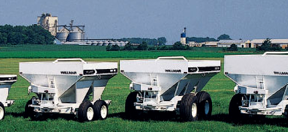Advanced Spreaders Deliver General Nutrient Application and Cost Savings
One of the greatest costs for any crop is the cost of amendments or fertilizers. This fertilizer cost has risen so dramatically in recent years that the even with high grain prices, farmers struggled to make a profit after investing in the necessary amendments for sufficient crop yields. One aspect for saving money on amendments is how the amendments get into the soil and to the seed where they are needed.
Spreaders are Older Technology, Still In Use World-Wide
Past spreaders used a general application method. A rotating wheel would sling powdered fertilizer as far as possible, while also sending dust into the air and requiring frequent agitation. Those systems, while still in use, are considered too inefficient and too costly when compared to the more precise methods now.
Sprayers have taken a majority of the large farm business from dry application spreaders. The reason is that sprayers offer more control, more precision, and often, better end result with liquid nutrients. Also, dry fertilizer application requires either rain for full effect, or another pass with a sprayer.
Broadcast Spreaders – Inexpensive Dry Fertilizer Application
Sprayers are still common in South America and in Brazil where there is relatively dependable rainfall and the sprayers are much more expensive. Spreaders are simple mechanisms and much less expensive generally than more complicated sprayers.
Agco’s Willmar brand makes dry fertilizer spreaders. They have the capability of moving over a ton of dry fertilizer per acre through single or double spinning wheels. Spreaders range from small walk behind systems to the 8 ton capacity S-800 units intended for larger operators that want to cover over a 100 acres before refilling the hopper.
Best Uses for Dry Broadcast Spreaders
One of the best uses for spreaders is broad fertilizer application. Limestone, general nitrogen amendments, and conditioners work well with a spreader. More expensive fertilizers including micro nutrients, plant specific chemicals, and expensive pesticides require more precise application through a sprayer.
Application rates for spreaders depend on the size of the spreader, how many disks – either single or double, speed of the tractor, and the properties of the dry fertilizer being spread. Generally, it is better to make multiple passes with a spreader instead of trying to get too much into the ground with one pass and creating more dangerous dust than necessary. Even though the spreaders claim to dial in an accurate rate for distribution, the mechanics of the tractor to spreader connection make this more of an estimate.
Spreaders have their place, even if sprayers are displacing them. General fertilizer application of less expensive foundation amendments make sense with a spreader. Expensive micro-nutrients do not work well when applied in a dry method. Stick to sprayers for those applications.



